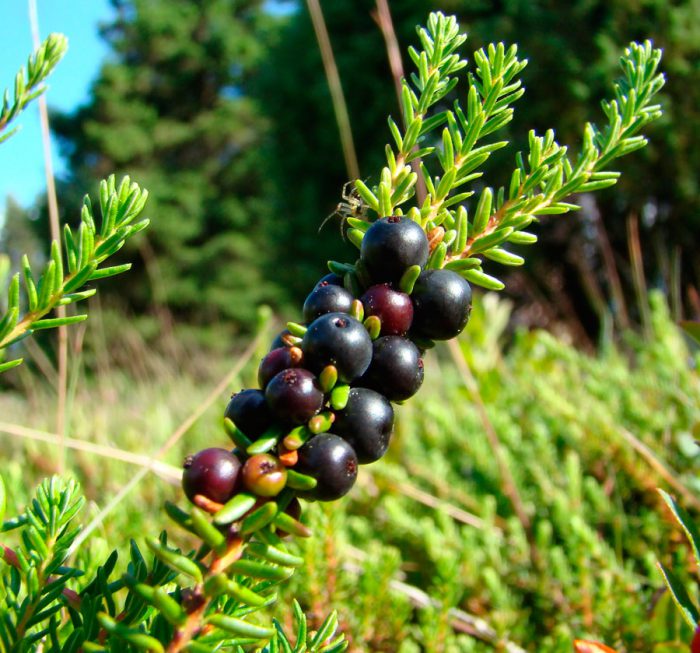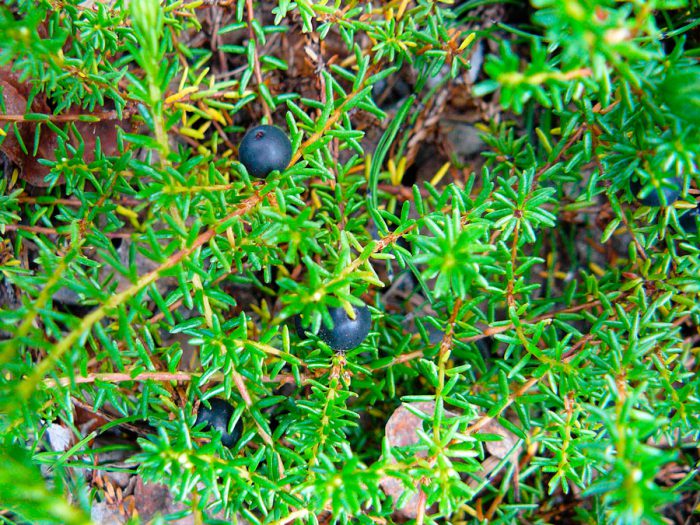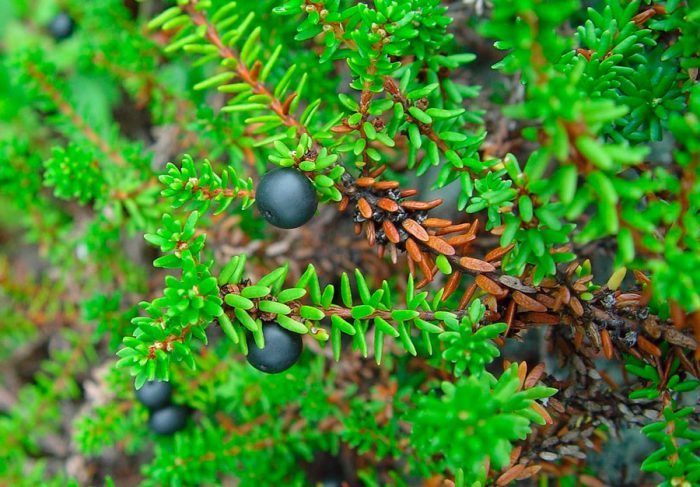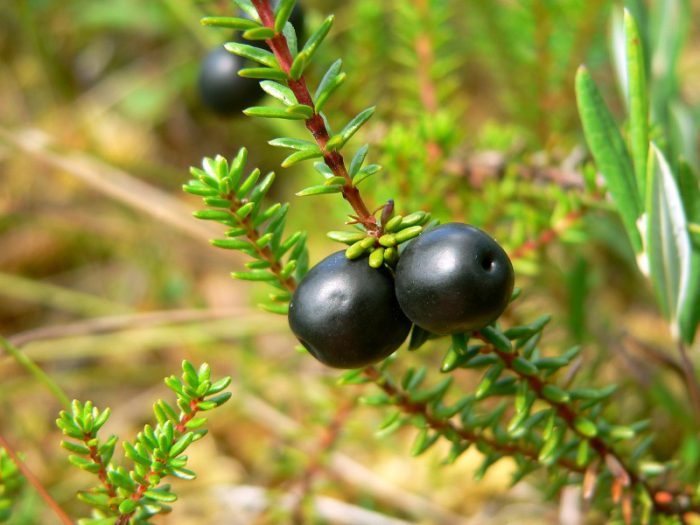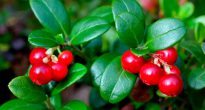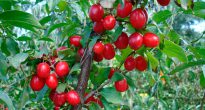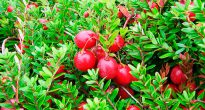Vodyanika (Empetrum), also called shiksha, or crows - this genus is represented by creeping low-growing shrubs, which are evergreen, it belongs to the Heather family. In such a shrub, leaf plates outwardly resemble needles, flowers do not represent any decorative value. In the Northern Hemisphere, such plants are widespread in natural conditions; they are much less common in South America. Also, this shrub is also called ordinary, berry or black dwarf birch, raven, lykha, veris, psycho, psycho berry, sixx, booze, bear berry, bush, black grass and pigeon. In the wild, it prefers to grow in pine forests, sphagnum bogs, tundra, open sands and granite deposits in the mountains of the subalpine and alpine belt.
Content
Features of Crowberry
Vodyanika is a creeping small shrub that reaches a height of only 20 centimeters. The stems can be up to 1 meter long. Such a plant is similar in characteristics to lingonberries. This shrub grows in clumps, while adventitious roots can grow on its branches, due to which the clump constantly grows, while there is a gradual dying off of the branches located in the middle of the bush. Strongly branching shoots are colored dark brown. Alternately located leathery leaf plates are outwardly similar to the needles of spruce, they densely cover the shoots. Each of the leaf plates does not fall off the bush for 5 years. Axillary flowers have 3 petals, which can be colored red, purple or pink. These flowers are inconspicuous. In mid-latitudes, shiksha blooms in April or May, while in Siberia - in May or June. For pollination, these shrubs require pollinating insects such as bees, butterflies and flies. Outwardly, shiksha berries are similar to blueberries. They are juicy sour fruits of a spherical shape and black color, which can reach 5.5 cm in diameter, inside they have 4 bones, and on the surface there is a bluish bloom. They begin to ripen in August, while they do not fall from the bushes throughout the winter. The juice obtained from such fruits has a purple color. Crowberry thickets are called shikshevniks or crows.
Also, this plant is distinguished by one more feature, it grows in symbiosis with a special fungus. It settles in the root system of a shrub and supplies it with photosynthetic products.
Planting and caring for shiksha
Planting shiksha in the garden
In the wild, shiksha, as a rule, prefers to grow in sunny areas, while the soil it needs is sour sandy or peaty. It should be remembered that crowberry reacts extremely negatively to stagnant liquid in the soil. Overly dense soil is not suitable for planting it. Therefore, if there is clay soil on the site, then it is necessary to add sand, peat and sod soil to it. To do this, remove the top layer of soil to the side and instead pour a layer of sand mixed with crushed stone ten centimeters thick. After that, the top layer of soil removed to the side must be mixed with the necessary additives and laid in its original place.
Shiksha should be planted at a depth of about 0.4 m. If several bushes are planted, then a distance of 0.3–0.5 m should be kept between them in a row. The curtains should be planted so that the root collar is 20 mm deep. The planted plants need good watering.
How to care for a shiksha
The water man needs to be weeded systematically, but only in the first years of life. After the shrub grows, it can suppress the growth of weeds. If the surface of the site is covered with a layer of mulch (peat), the thickness of which should be 50 mm, then this will help to significantly reduce the number of watering and weeding. Watering should not be very frequent, because such a plant reacts negatively to stagnant liquid in the soil. As a rule, shiksha is watered only during dry periods.
The shrub will need only 1 feeding with Nitroammofoskoy throughout the season (50 grams per 1 square meter of plot). In spring, he needs sanitary pruning, for this he needs to cut out all frost-damaged and dried stems. When pruning such a plant, you need to remember that it is slow-growing, so this procedure should be carried out very carefully. Shelter for such a shrub for the winter is not required, because it is quite frost-resistant. It tolerates the winter months well under snow cover.
Shiksha collection and storage
Crowberry fruits and branches with foliage have healing properties. Grass is harvested during the flowering period, and the fruits - as soon as they ripen. Prune the grass carefully because you cannot injure the plant's root system. Spread out the grass in a thin layer, choosing a shaded area that should be reliably protected from rain and direct sunlight. Raw materials can also be dried in a dark, well-ventilated room. During drying, the grass must be systematically agitated, in this case, uniform drying will be ensured. After the grass is dry, it must be placed in cloth bags, which are stored in a dark and dry place. Such raw materials can be stored for two years.
Types and varieties of shiksha
This genus has different classifications. So, according to some scientists, this genus is monotypic, while chokeberry or black shiksha is the only species. Other scientists believe that this genus unites not one, but several species: bisexual crowberry, black, red, almost-Holarctic. And the Plant List database contains the following information that the Crowberry genus unites only 3 species and 8 subspecies. Only 1 species is cultivated by gardeners.


Black crowberry (Empetrum nigrum), or black-fruited, or Siberian shiksha is a strongly branched shrub that is evergreen, it reaches a height of 0.25–0.5 m. The shape of the crown is cushion-shaped. In the wild, this culture prefers to grow in peat bogs, while they do not need high humidity at all. Linear sheet plates reach 10 mm in length, their edges are turned down. The color of the front surface is dark green, while the purl has a dense pubescence, represented by a pile of red color. The color of the flowers is pink, red or dark red, they have only 3 petals.There is a bluish bloom on the surface of black spherical fruits. They ripen in August-September. These berries are watery and tasteless. This plant has 2 varieties: Japanese and Asian. He also has several decorative varieties:
- Citronella. The bush has a glossy lush lemon-yellow foliage.
- Emerald. The creeping bush has dark green leaf plates.
- Bernstein. The color of the leaf plates is pale yellow.
- Lucia. The foliage is yellow.
- Ireland. The creeping branches are covered with dense glossy green leaves.
Shiksha properties: harm and benefit
The healing properties of shiksha
Shiksha contains saponins, flavonoids, tannins, alkaloids, fatty and essential oils, resins, coumarins, benzoic and acetic acids, fructose, anthocyanins, carotene, ascorbic acid, andromedotoxin, sugars and trace elements.
In alternative medicine, decoctions and infusions are prepared from such a plant, they are used for scurvy, epilepsy, insomnia, schizophrenia, colitis, convulsions, difficulty urinating, chronic gastritis, liver and kidney diseases, headaches, hypertension, metabolic disorders, depression, dropsy, diarrhea, paralysis, edema, and anthrax. They are also used externally to treat wounds, ulcers, rashes and acne. Decoction of the foliage perfectly strengthens the hair.
Infusion of Crowberry will help those who have watery and dry eyes. To prepare it, you need to combine 1 liter of freshly boiled water and 2 large tablespoons of grass, you need to wait until it is steamed. The cooled infusion must be filtered through cheesecloth rolled into 3 or 4 layers. The infusion should be instilled into the eyes every 2-3 hours.
With increased nervousness, a remedy made from shiksha will also help. To prepare it, you need to combine half a liter of boiled water with a couple of large spoons of grass. The mixture is put on low heat for 5-7 minutes. Remove the product from the heat, wrap it up and wait until it cools completely. The filtered drink should be drunk 4 or 5 times a day, 3 large spoons.
Harm
There are shiksha fruits, and it is forbidden to use drugs from this plant for individual intolerance, as well as for pregnant and lactating women.
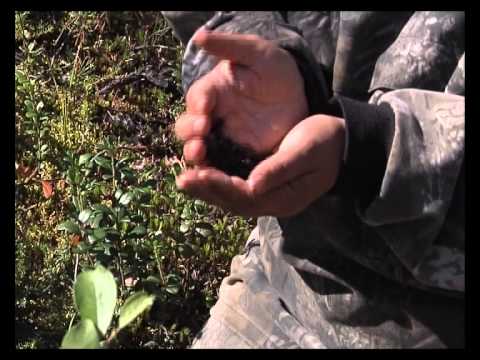

Watch this video on YouTube

